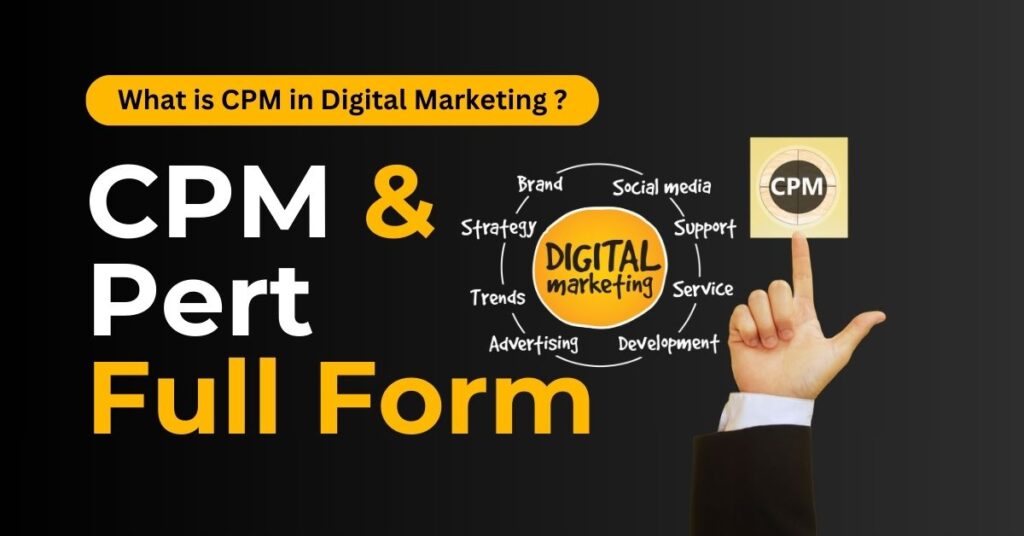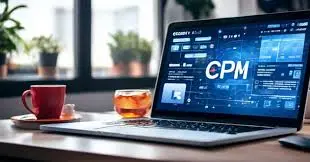
Digital Marketing Digital Marketing career 360 Digital Marketing Agency 10 Min In this Articles The
🪔Limited-time Diwali offer! Message “DIWALI” on WhatsApp to get yours! 🎉


Digital marketing is a dynamic industry that has transformed how businesses connect with their audiences online. As you explore this field, you will come across various terms that might sound similar but have different meanings and uses. Understanding these differences is key to effectively navigating the digital world.
In this blog, we will focus on one such term—CPM. What is CPM in Digital Marketing? CPM full form in digital marketing, CPR in digital marketing, CPM and PERT full form, what is impression in digital marketing, advantages and disadvantages of CPM, limitations of CPM, and explore its role in digital marketing.
In digital marketing, CPM stands for “Cost Per Thousand Impressions.” The “M” in CPM comes from the Latin word “mille,” meaning thousand. This metric measures the cost an advertiser pays for every 1,000 impressions (views) of their ad.

CPM stands for “Cost Per Thousand Impressions” in digital marketing. It is a metric used to measure the cost of 1,000 ad impressions on a webpage. CPM is commonly used in display advertising, where you pay a set fee for every 1,000 times your ad appears. It is a useful way to estimate the cost of reaching a large audience and helps businesses plan and budget their advertising campaigns effectively.
CPM is particularly relevant in display advertising, video ads, and social media marketing, where the primary goal is to showcase the brand or product to as many people as possible. It is a metric that aligns with top-of-the-funnel strategies, aiming to capture the attention of potential customers.
For example, if a website charges a CPM rate of $10, and your ad is displayed 1,000 times, you will pay $10 for those 1,000 impressions. If your ad is displayed 10,000 times, you will pay $100.
In digital marketing, an “impression” refers to the number of times an ad is displayed or seen by users on a webpage or app. Each time your ad appears on a user’s screen, it counts as one impression, regardless of whether the user interacts with it or not. Impressions are a basic metric used to measure the reach of an advertisement and help marketers understand how often their ad is being shown.
While CPM is widely known in the advertising world, PERT is another term often associated with project management rather than digital marketing. PERT stands for Program Evaluation and Review Technique. It i a project management tool used to plan, schedule, and control complex projects.
Though PERT and CPM sound similar, they serve different purposes. CPM in digital marketing deals with the cost of ad impressions, while PERT focuses on project timelines and task management. However, both are crucial in their respective fields for optimizing performance and achieving goals.
CPR, or Cost Per Response, is another important metric in digital marketing, though it is less common than CPM. CPR measures the cost incurred for each response or interaction with an ad, such as a click, form submission, or purchase.
CPR is particularly useful for performance-based campaigns where the objective is to drive specific actions from users. Unlike CPM, which focuses on impressions, CPR homes in on user engagement, making it a better fit for campaigns with conversion goals.

While CPM is a valuable metric in digital marketing, it comes with certain limitations:
CPM is a fundamental metric in digital marketing, offering a cost-effective way to measure the reach of your advertising campaigns. It is particularly useful for brand awareness initiatives, where the primary goal is to display your ad to as many people as possible. However, it is important to consider the limitations of CPM, especially in terms of engagement and conversion tracking. By understanding both the advantages and disadvantages of CPM, you can make informed decisions about how to allocate your advertising budget and achieve your marketing objectives.
Whether you choose CPM, CPR, or another pricing model, the key to success in digital marketing lies in aligning your metrics with your campaign goals. With a clear understanding of CPM and its implications, you can optimize your strategies for maximum reach and impact.
5G is the fifth generation of wireless technology that offers significantly faster data speeds, lower latency, and higher device connectivity compared to 4G. These advancements enhance user experience and open up new possibilities for businesses, including digital marketing.
With faster internet speeds and seamless connectivity, customers can access high-quality content like videos, AR/VR experiences, and live streams without buffering. This enhances engagement and ensures a smoother user journey, leading to higher conversion rates.
Yes, 5G will significantly impact mobile advertising. Marketers can now create highly interactive and visually rich ads using AR/VR and 3D graphics, which will load faster and perform better, providing users with a more immersive experience.
5G enables faster video loading and streaming in 4K or even 8K quality without buffering. This encourages marketers to prioritize video content, such as live streaming, interactive video ads, and personalized video campaigns.
Yes, 5G facilitates real-time data collection and analysis due to its low latency. Marketers can gather and process customer behavior data faster, allowing for more precise targeting and personalized marketing strategies.
5G supports high-bandwidth applications like augmented reality (AR) and virtual reality (VR). These technologies can be integrated into digital marketing campaigns to offer interactive experiences, such as virtual product try-ons or immersive brand storytelling.
With 5G, online shopping experiences can become more interactive and personalized. Features like real-time virtual assistants, live product demonstrations, and faster website/app loading times will improve customer satisfaction and drive sales.
While 5G offers many benefits, challenges include the high cost of implementing advanced technologies like AR/VR, the need for updated infrastructure, and the digital divide where not all regions have 5G coverage yet.
5G’s real-time data processing capabilities allow marketers to deliver hyper-personalized content based on user behavior, location, and preferences, enhancing the customer experience and driving engagement.
Small businesses should consider adopting 5G-based strategies gradually. The improved connectivity allows them to leverage innovative tools like live streaming, personalized video ads, and interactive content to compete with larger brands effectively.
Industries like retail, entertainment, gaming, real estate, healthcare, and education will benefit significantly as they can use 5G to create highly interactive, immersive, and engaging marketing campaigns.
Yes, 5G will enhance website performance by ensuring faster loading times, even for content-heavy websites. It also enables better user experience (UX), which is a key ranking factor for SEO.
Marketers should focus on creating high-quality video content, exploring AR/VR opportunities, optimizing websites and apps for speed, and investing in tools that can handle real-time data to stay competitive in the 5G era.

Digital Marketing Digital Marketing career 360 Digital Marketing Agency 10 Min In this Articles The

Digital Marketing Digital Marketing career 360 Digital Marketing Agency 10 Min In this Articles Social

Digital Marketing Digital Marketing career 360 Digital Marketing Agency 10 Min In this Articles The

Thanks for Asking Your Question
How can I access additional resources
for this course?